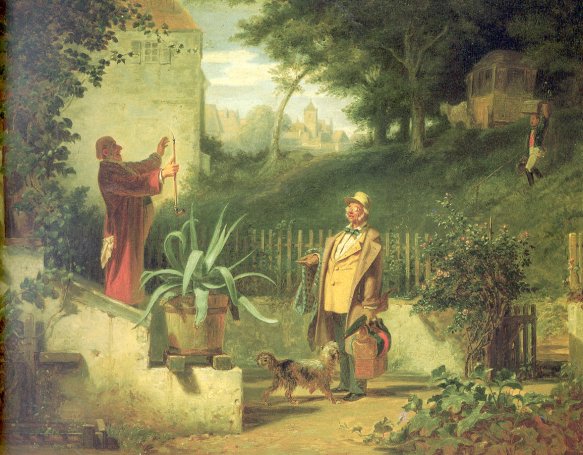Carl Spitzweg - the painting pharmacist
Carl Spitzweg was born on February 5th, 1808 in Munich. After his school-days he first worked as a pharmacy trainee, before - from 1830 until 1832 - studying pharmacy at the university of Munich. During his years of study he simultaneously worked as a chemist's assistant in Straubing.
As far as his artistic career is concerned, Spitzweg is a pure self-taught man. At first he schooled himself by copying Flemish masters in the "Alte Pinakothek". Additional inspiration he got from friends like Christian Morgenstern and others.
Spitzweg gathered his first artistic experiences in the 30s and 40s as a sketch-artist for satiric magazines ("Nürnberger Trichter", "Fränkische Blätter"). Next to this small format paintings arose also, such as "Der arme Poet" ("The poor poet", 1839).

CARL SPITZWEG, THE POOR POET
The poor poet is one of Spitzwegs best known and most beloved paintings. It exists in two almast identical versions, the original in Berlin and the second interpretation in the "Neue Pinakothek" in Munich. The base theme of the intellectual was used in many variations by Spitzweg. In this case a distressed poet has apparently found refuge in a miserable attic, where he can get away from everyday life and its pain, the material shortages, to be an »Idealist« and indulge the psychical aspects of life. In contrast to the compositive corresponding depictions of the French art of painting in the 18th century, Spitzweg ironisizes his subject which has, besides the romatic-biedermeieric contemplation, also grotesque features. The scene is defined by a grim but at the same time sympathetic humour. The representation of the light entering through a window in the background as well as the blurry shadows, the clear composition and the detailed painting shows resemblance with the dutch genre painting of the 17th century. The flight from the social and political reality in the painting is at the same time a caricature of the biedermeieric lower-middle-class attitude.
Spitzwegs second production period starts with a journey to Prague in 1849, during which he studies the English landscape painter John Constable. There follow journeys to Venice (1850), Paris, London and Belgium (1851). During this time Spitzweg specifically concerns himself with the works of Delacroix and the school of Barbizon. As a result of these studies he changes the color composition of the depicted scenes in his paintings and gains a superb mastership of the differentiation of moonlight or beginning twilight

The work of the older Spitzweg is characterized by an easy, almost impressionistic, painting style, the story-telling element moves to the background. Examples are "Der Antiquar" ("The antiquary", around 1880) and "Päpstliche Zollwache" ("Papal customs", 1880).
On september 23rd, 1885 Carl Spitzweg dies in his hometown Munich.

He is considered to be one of the most important representatives of the Biedermeier era. His keen eye for observing human peculiarities made it possible for him to grant his paintings a comical-thoughtful charm - sometimes coupled with an exotic-fantastic touch - which made him the most popular artist with the common man. Also the often figurative side-issues in his landscape paintings play an important role in his creative processes. Emphasized in this connexion must be among others "Heuernte im Gebirge" ("Hayharvest in the mountains", about 1865) and "Auf der Alm" ("On the Alp", 1880).